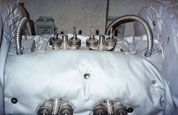| |
Basic Construction: Outer Jacket

 Figure 5 Figure 5
|
|
There are several examples of outer jackets.
Silicone-Impregnated Cloth
For functional all-round general service, this material is also a very good selection as an outer jacket, as well as a liner. The matrix cloth is usually a glass fiber weave with a through-thickness impregnation of high temperature silicone. This cloth is easily handled, impervious to the elements, very flexible, has excellent tear strength and is resistant to cracking, even in sub-zero temperatures.
Fluorocarbon (Teflon) Coated Cloth
Though this material can be pressed into general service, it's best reserved for special applications in special environments. For example, these include environments subject to very aggressive corrosive attack, which would degrade other materials, or where complete cleanability and washdown are critical. Examples of the latter are in the food, pharmaceutical or nuclear industries.
One of the limitations of this material is that the fluorocarbon is coated onto the base glass fiber cloth, not through-thickness impregnated. A coating outcome is that the material wrinkles easily (think linen shirt versus permanent press). When the cover cools and is handled during several installations and removals, especially in cold temperatures, the material and coating tends to crack along the wrinkle lines.
Aluminum Foil Laminated to Glass Fiber Cloth
With the aluminum foil presented on the outside, this material gives a consistent look to an overall insulation installation. It's low cost, but doesn't have high puncture, weather or fluid-ingress resistance properties. It has the same limitations to steam and temperature exposure when used as an outer jacket as when used as liner, as mentioned earlier in this article.
Stainless Steel Foil Laminated to Glass Fiber Cloth
Use of this material provides a puncture-proof jacket. However it retains the same constraints when used as a jacket as it does when used as a liner: It can't be folded due to its lack of flexibility, and it also can't be sewn. Construction of the finished product entails using "hog rings" to join it at the edges of the jacket, to the inner liner or to an intermediate gusset. This construction method makes the overall finished piece of insulation difficult to weatherproof if used outside, or to prevent the ingress of fluids to the insulation layer if used indoors. Also, except in specific applications, use of hog rings as a joining method has now become virtually obsolete in manufacturing quality removable-reusable insulations.
Stainless Steel Knitted Mesh
This mesh can be added over any jacket to provide tear resistance (but not puncture resistance), to a jacket. Think of it as a kind of "chain mail" or "rip-stop" mesh for the jacket. Use of this mesh is now also becoming obsolete now that higher tear-resistant materials for constructing the outer jacket are available. Also, historically, this mesh has been hog-ringed in place, thus introducing the same weather and moisture-ingress problems as the previously mentioned stainless steel foil laminated to glass fiber cloth.
Vinyl Outer Covers
Vinyl outer covers in colors such as bright yellow and international orange can be supplied to the shape of removable-reusable insulations. The intent is to give the equipment high visibility. This can be for safety reasons, such as warning personnel to stay clear or use safety equipment. Steam pressure relief valves (PSV's), are a good example (as shown in Figure 5). The noise level in proximity to large steam PSV's when they release is high enough to burst eardrums and cause hearing damage.
|
|

